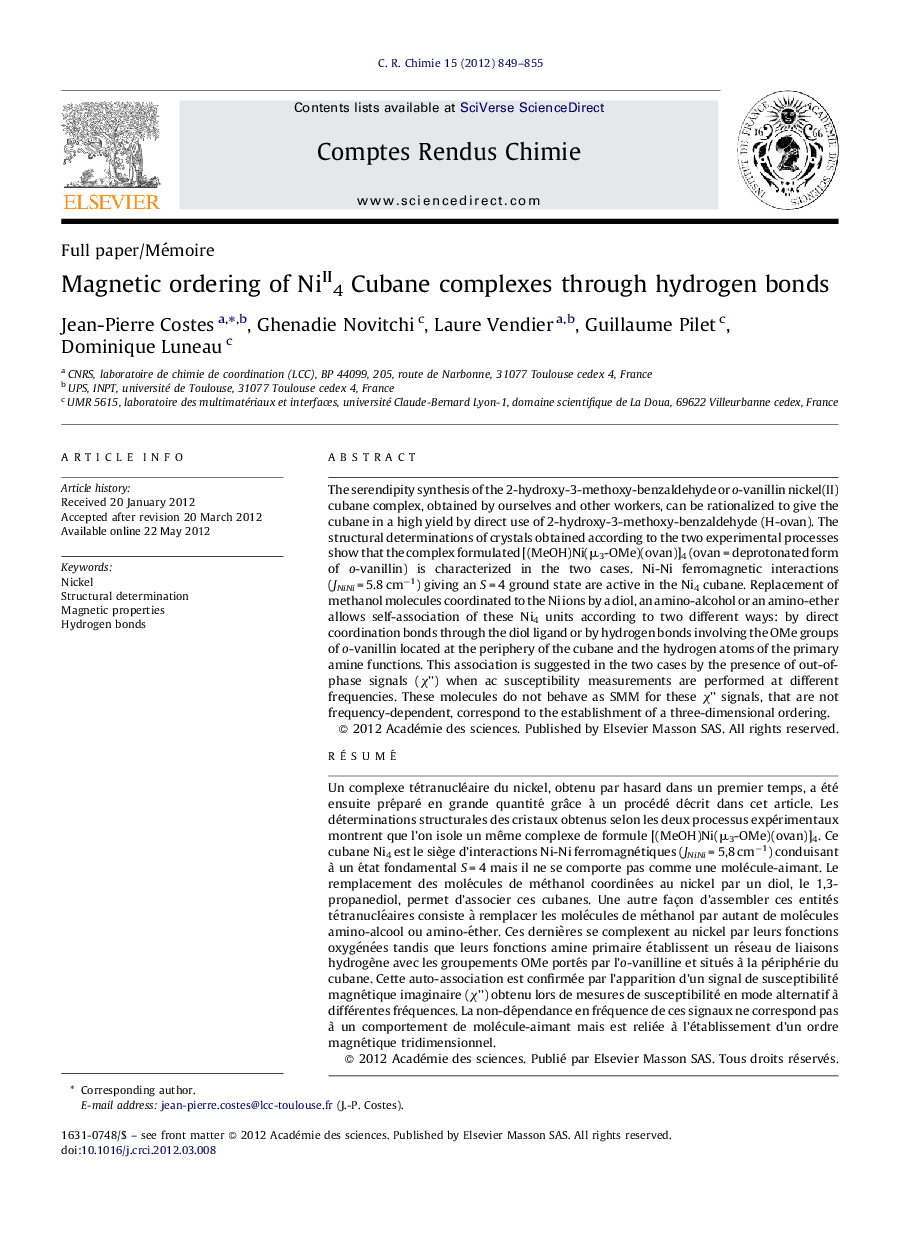| کد مقاله | کد نشریه | سال انتشار | مقاله انگلیسی | نسخه تمام متن |
|---|---|---|---|---|
| 171017 | 458429 | 2012 | 7 صفحه PDF | دانلود رایگان |

The serendipity synthesis of the 2-hydroxy-3-methoxy-benzaldehyde or o-vanillin nickel(II) cubane complex, obtained by ourselves and other workers, can be rationalized to give the cubane in a high yield by direct use of 2-hydroxy-3-methoxy-benzaldehyde (H-ovan). The structural determinations of crystals obtained according to the two experimental processes show that the complex formulated [(MeOH)Ni(μ3-OMe)(ovan)]4 (ovan = deprotonated form of o-vanillin) is characterized in the two cases. Ni-Ni ferromagnetic interactions (JNiNi = 5.8 cm−1) giving an S = 4 ground state are active in the Ni4 cubane. Replacement of methanol molecules coordinated to the Ni ions by a diol, an amino-alcohol or an amino-ether allows self-association of these Ni4 units according to two different ways: by direct coordination bonds through the diol ligand or by hydrogen bonds involving the OMe groups of o-vanillin located at the periphery of the cubane and the hydrogen atoms of the primary amine functions. This association is suggested in the two cases by the presence of out-of-phase signals (χ”) when ac susceptibility measurements are performed at different frequencies. These molecules do not behave as SMM for these χ” signals, that are not frequency-dependent, correspond to the establishment of a three-dimensional ordering.
RésuméUn complexe tétranucléaire du nickel, obtenu par hasard dans un premier temps, a été ensuite préparé en grande quantité grâce à un procédé décrit dans cet article. Les déterminations structurales des cristaux obtenus selon les deux processus expérimentaux montrent que l’on isole un même complexe de formule [(MeOH)Ni(μ3-OMe)(ovan)]4. Ce cubane Ni4 est le siège d’interactions Ni-Ni ferromagnétiques (JNiNi = 5,8 cm−1) conduisant à un état fondamental S = 4 mais il ne se comporte pas comme une molécule-aimant. Le remplacement des molécules de méthanol coordinées au nickel par un diol, le 1,3-propanediol, permet d’associer ces cubanes. Une autre façon d’assembler ces entités tétranucléaires consiste à remplacer les molécules de méthanol par autant de molécules amino-alcool ou amino-éther. Ces dernières se complexent au nickel par leurs fonctions oxygénées tandis que leurs fonctions amine primaire établissent un réseau de liaisons hydrogène avec les groupements OMe portés par l’o-vanilline et situés à la périphérie du cubane. Cette auto-association est confirmée par l’apparition d’un signal de susceptibilité magnétique imaginaire (χ”) obtenu lors de mesures de susceptibilité en mode alternatif à différentes fréquences. La non-dépendance en fréquence de ces signaux ne correspond pas à un comportement de molécule-aimant mais est reliée à l’établissement d’un ordre magnétique tridimensionnel.
Journal: Comptes Rendus Chimie - Volume 15, Issue 10, October 2012, Pages 849–855